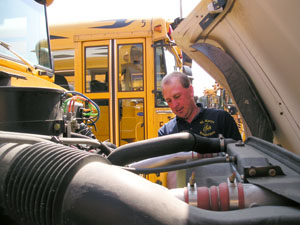By Janie Southard
jsouthard@dailystandard.com ST. MARYS -- The 39 city school buses will be running on soybeans this year as the district opts for biodiesel fuel.

Transportation Supervisor Dan Grothaus got the nod of approval from board of education members at July's meeting to proceed with plans to purchase a B20 mixture from Burke Petroleum in Minster for the coming school year.
"B20 is a blend of 20 percent biodiesel and 80 percent regular diesel, which costs only 2 cents a gallon more when I last researched it. You know how fuel costs fluctuate, but that's about an average comparison," Grothaus told The Daily Standard this week at the district's bus garage.
Biodiesel is a clean-burning alternative fuel derived from natural oils, such as soybean oil, for diesel engines. It contains no petroleum, but can be blended at any level with petroleum diesel to create a biodiesel blend, according to the National Biodiesel Board Web site. The site also says the fuel is biodegradable, nontoxic and essentially free of sulfur and aromatics.
Grothaus, who began with the district in 1988 as a bus driver, said he first looked into biodiesel about 10 years ago when a bus driver, who also was a farmer, recommended the new fuel. "He'd used it in all his farm equipment and was very pleased with it. But expense has been a factor until the new tax incentives, plus some grants have become available through the Ohio EPA," he said, adding the district is in the process of applying for the grants.
Currently the IRS is working on the language of the application forms and procedures for the tax incentive.
St. Marys district, the first in the area to go with biodiesel, will spend about $600 more to purchase the fuel, but Grothaus said some studies show a 5 percent increase in fuel economy. Last school year the district spent $57,571 for 30,856 gallons of diesel. If the 5 percent savings is correct, he estimates the district will save about 1,500 gallons for a $3,000 savings.
There are a number of other attributes Grothaus favors: the reduced dependence on imported fuel, it's a renewable fuel produced by farmers, no engine modifications are required, and most important, he said, is that the fuel is better for the environment and thus better for the kids.
"I have asthma myself so I know what respiratory problems are like. Regular diesel exhaust contains small particles, smog-forming and toxic air pollutants. That can cause lung damage and exacerbate asthma and allergies," he said.
Yes, there is a drawback to biodiesel. Colder weather can cause it to thicken, resulting in a lot of buses stranded at the garage because they won't start. Any diesel fuel has the potential to gel but the odds with biodiesel are a little greater.
"We don't know that that will happen. But if it does, there are several options. We can use 100 percent diesel for a while, same as we've been using. Plus we can drop down to 10 percent biodiesel or 2 percent biodiesel," he said. "At any rate, this concern is outweighed by the many benefits we'll gain." |

